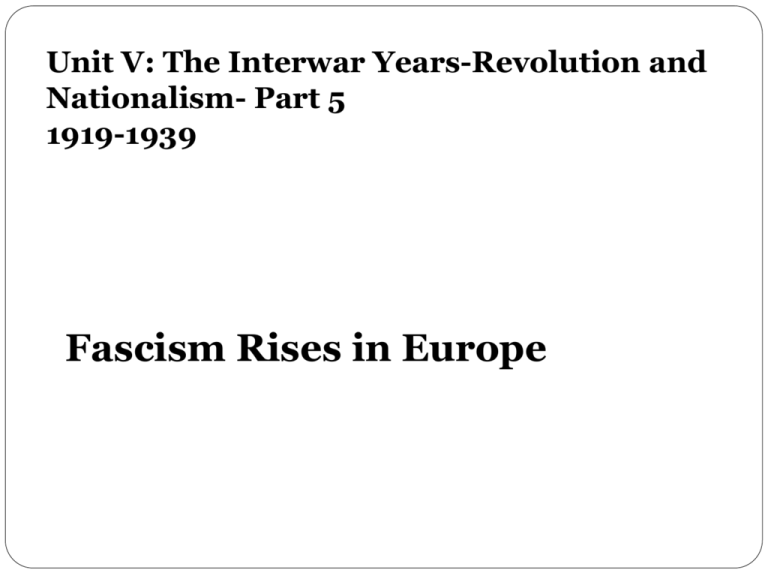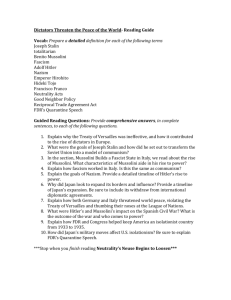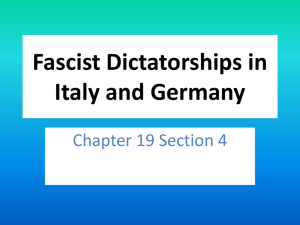Rise of Fascism
advertisement

Unit V: The Interwar Years-Revolution and Nationalism- Part 5 1919-1939 Fascism Rises in Europe The Rise of Fascism Video Link: “The Rise of Fascism” The Rise of Fascism (9:58) The Rise of Fascism in Italy Benito Mussolini Postwar Economic Problems in Europe After WWI, Europe faced severe economic problems: Inflation Worldwide depression New democracies weak and ineffective in addressing these problems. Economic despair caused people to lose faith in democratic government and turn to an extreme system of government called fascism. Fascism Political ideology invented by Mussolini and introduced in Italy in the 1920s. Word derived from the Latin “Fasces”~ meaning “bundle of sticks”. A bundle of sticks wrapped around an axe became the symbol of the Fascist party in Italy. Characteristics of Fascism Ultra- conservative (reactionary) nationalism. Constant use of patriotic mottos, slogans, symbols, songs, etc. Flags are seen everywhere. Create a patriotic frenzy over the need to eliminate a common threat or “enemy” Can be racial, ethnic, a religious minority, liberals, communists, etc. Totalitarianism • Demands absolute obedience to the state and to an authoritarian leader. • Government controls all aspects of society. • One-party dictatorship. People denied individual rights. • Anti-democratic Characteristics of Fascism (con’t) Organized violence used to suppress opposition. Militaristic, expansionist foreign policy. Preserves capitalism, but with state control of large corporations. Main supporters: Upper and upper-middle classes and industrialists Enemies: Labor unions, socialists, and communists . Where is fascism on the political spectrum? Support for Fascism in Italy and Germany. WHY? Fascist leaders in countries like Germany and Italy promised to revive the economy, rebuild the military, and restore national pride. People turned to these leaders out of desperation. People in both countries were desperate for strong leaders who would take action. Benito Mussolini Rises to Power in Italy “My objective is simple. I want to make Italy great, respected, and feared.” - Benito Mussolini Benito Mussolini’s Appeal? Great orator who roused audiences with emotional speeches. Italy left in financial ruin after WWI. Mussolini stirred up people against the countries that had emerged rich and strong from the war. Appealed to national pride. Vowed to restore the glory of the Roman Empire. Promised to revive Italy’s economy and rebuild its armed forces. Promised to restore ORDER! Mussolini’s Appeal "Mussolini is a riddle to me. Many of his reforms attract me. He seems to have done much for the peasant class. I admit an iron hand is there. But as violence is the basis of Western society, Mussolini's reform deserve an impartial study… What strikes me is that behind Mussolini's implacability is a desire to serve his people. Even behind his emphatic speeches there is a nucleus of sincerity and of passionate love for his people. It seems to me that the majority of the Italian people love the iron government of Mussolini.“ - Mohandas Gandhi Mussolini’s Appeal “If I had been Italian, I am sure I would have been with you from the beginning.” - Winston Churchill (1930s) Mussolini Comes to Power in Italy Founded Fascist Party in 1919 and gained support as Italy’s economy worsened. His “Black Shirts” attacked Communists and Socialists. Gained the support of what groups? Those who feared a worker’s revolt– the middle classes, the aristocracy, landowners and industrial leaders. Mussolini’s Private Army - The Black Shirts Mussolini Comes to Power 1922 – 30,000 Fascists marched on Rome. Demanded that King Emmanuel III put Mussolini in of the government. Threatened with armed uprising. the king agreed to appoint him Prime Minister. Mussolini proclaimed himself to be Il Duce (ihl DOO-chay) (“The Leader” or “The Boss’). charge Mussolini in Power Abolished democracy and outlawed all political parties except Fascists. Political opponents imprisoned. Forced media to broadcast or print only Fascist doctrine. Seized control of the were banned. economy. Strikes by workers Allied with industrialists and large landowners. Goals: Establish overseas empire in Africa and militaristic state at home. A & E Biography on Mussolini (46 min) The Rise of Nazism in Germany Adolf Hitler Germany Between the Wars Germany left greatly weakened by Treaty of Versailles. Strong resentment among the German people over terms of treaty. Suffered from inflation (1920s) and depression (1930s). Weimar Republic (post WWI democratic government), had signed Versailles treaty. It was blamed by Germans for the nation’s problems. Paul von Hindenberg President of Weimar Republic The Rise of Adolf Hitler 1920: Joined small, right-wing National Socialist German Workers Party (NAZI Party). Hitler gained control of the National Socialist party by 1921. A young Adolf Hitler Nazism German brand of fascism Core beliefs: 1. Extreme nationalism 2. Racial superiority • A belief that Germans were a superior people destined to rule all of Europe. • A belief in the expulsion of inferior peoples. Hatred of Jews Hatred of Slavs 3. Anti-communism The Nazi Party middle Supported by _______ lower-middle and ______________ classes. Nazi Party adopted the swastika as its symbol. _______ (Aryan Symbol of the sun) Organized private militia storm troopers (the SA) of _______________ Brown Shirts also known as ________. 1923 Failed Munich “putsch” Under Hitler, Nazis plotted to seize power in Munich in 1923. Attempt to overthrow government failed. Hitler arrested; sentenced to five years in prison for treason. Only served nine months. Mein Kampf (“My Struggle”) Book written by Hitler in prison. Outlined his goals of territorial expansion. Said Germany needed more “living space” (lebensraum) and outlined plans to conquer Eastern Europe and Russia to get it. Blamed the Jews and Communists for all of Germany’s problems. Mein Kampf (con’t) Asserted the Germans (“Aryans”) were a “master race” Non-Aryans (Jews, Slavs, Gypsies) were inferior or subhuman. Outlined his plans to create a racially-pure nation that would dominate the world. Hitler’s Road to Power Released from prison in 1924. Built up Nazi party. 100,000 members by 1928. 1928 election: Nazis only won 2.6 percent of popular vote. Largely ignored as extremist group -- until the German economy collapsed. During Depression, middle / lower class Germans attracted to Hitler’s appeals for “national rebirth.” 1932 elections: Nazis won 38% of the vote and became largest party in the Reichstag. 1933 Hitler Appointed Chancellor President von Hindenberg pressured to appoint Hitler chancellor in 1933. Hitler supported by conservative politicians and key leaders in the army and big business leaders. These leaders mistakenly thought they could control and use Hitler. Nazis Elected to Power Reichstag (Parliament) building destroyed by fire just before 1933 elections. Nazis blamed the Communists. Stirring up fear of communism, Nazis won enough seats to take control of the Reichstag. Nazi controlled Reichstag passed Enabling Act -- law appointing Hitler to new post of “Fuhrer” with absolute power. Communists arrested after the Reichstag fire Germany Becomes Totalitarian State Germany became a one-party Nazi state. The SS, loyal only to Hitler, arrested and murdered hundreds of Hitler’s political enemies. Communists, Social Democrats, trade-union leaders arrested. Terror carried out by Gestapo (Nazi secret police) June 30, 1934 “Night of the Long Knives” Army saw SA radicals as a threat. To win support of the army, Hitler purged Nazi Party of SA extremists. Hundreds of SA leaders who had helped Hitler come to power were arrested by the SS and executed without trial. German Army now pledged its supported for Hitler. Hitler and SA leader Ernst Rohm, who Hitler had killed in 1934. Public opinion shaped by government propaganda and censorship. Books that didn’t conform to Nazi beliefs were burned "One People, One Government, One Leader!" The Hitler Youth School children were forced to join the “Hitler Youth” Was an extension of the Nazi military structure that sought to prepare future generations for responsibility of continuing its reign. Indoctrinated German children so as to perpetuate the beliefs of the Nazi ideology. "Youth serves the Fuhrer. All ten-year-old boys join the Hitler Youth" "All Girls Join Us" German Video on Hitler Youth Mass rallies staged to generate enthusiasm for Nazi goals Nazi Anti-Semitism Hatred of Jews a key part of Nazi ideology. Jews made up less than 1 percent of Germany’s population, but were made scapegoats for all of Germany’s problems. Nazis passed laws (the Nuremberg Laws) stripping Jews of their rights and eventually, their German citizenship. Nazi Anti-Jewish Propaganda November, 9, 1938 Kristallnacht “Night of the Broken Glass” The start of an organized campaign to eliminate Jews from German life. Nazi mobs attacked Jews in their homes and on the streets. Ninety Jews were killed. Thousands arrested. Thousands of Jewish-owned buildings, businesses, and synagogues destroyed by fire and bombs. What will become the Holocaust has begun… Next .... Nazi aggression leads to war









